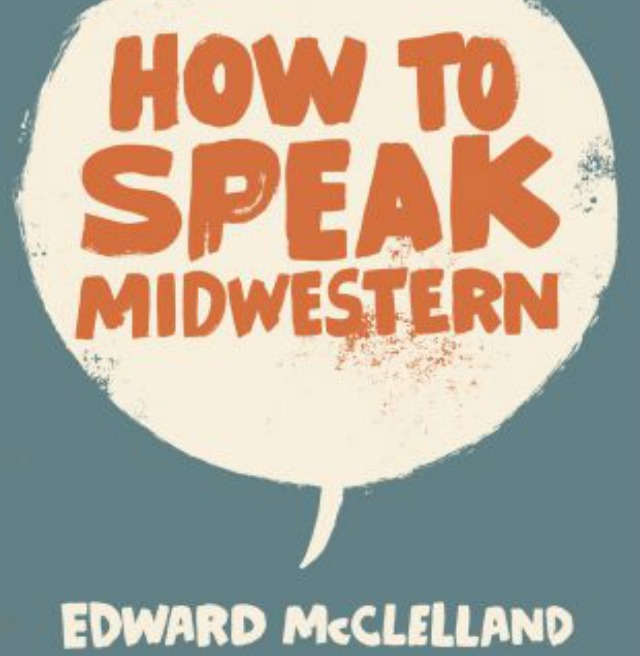'How To Speak Midwestern' Explores Origins Of Chicago's Strangest Language Quirks & More
By Rachel Cromidas in Arts & Entertainment on Dec 1, 2016 9:34PM

This holiday season, you too can speak like a Midwesterner, fellow Chicago transplants: let Edward McCelland's new book, How To Speak Midwestern be your field guide to 16-Inch, Quad Cities Style pizza, lutefisk, the U.P., "you betcha," and of course, "Dese, dem and dose."
The book, out now from Belt Magazine Books, grew out of an article McClelland wrote for Belt Magazine last year about a speech pattern known as the short-a-rising. He wanted to investigate the origins of other Midwestern speech patterns and unique phrases, and better understand why some were disappearing.
McClelland had previously written about about the Midwest in Nothin' But Blue Skies and The Third Coast, a book about traveling around the five Great Lakes on a Great Lakes Circle Tour. While working on that book, he said he gained inspiration for the book from trying some of the Midwest’s most well-known cuisines—think kringle in Wisconsin, beef on weck in Buffalo, and (A Prairie Home Companion fans will know this one) lutefisk in Minneapolis.
Chicago-speak is just one small part of the book, which visits three distinct regions around the Midwest that have their own particular speech patterns. If you want to know why some Minnesotans pronounce "wash" as "worsh," start in the North Central chapter. But we're a Chicago publication, and McClelland's explanation of how Chicago developed—and then lost—some of its most telling pronunciation quirks is enthralling.
Chief among them: Is it Chi-caw-go, with a caw sound, or Chi-cah-go, with a cah sound? If you ask Mayors Richard M. and Richard J. Daley, it’s caw—a pronunciation that is traced back to working-class families who settled in Chicago around WWII. But if you ask Rahm Emanuel or Barack Obama, it’s cah all the way—and in the battle for vernacular dominance, caw has been losing out to cah for some time now.
“What you consider the classic Chicago accent is really strongest in the WWII generation and the baby boomers,” McClelland told Chicagoist. To hear the remnants of this accent in action, McClelland said he went to Wrong’s Tap in Beverly earlier this fall to watch a Bear’s game.
“I wanted to hear what you would call the classic Chicago accent in its natural habitat. Guys were saying things like, ‘what's the square for this game? Zero and tree,’ and ‘da Bears,’ and ‘jagoff.’ It was all there,” he said.
But while the accent is still in play in certain historic neighborhoods on the city’s far South Side, among a certain generation of residents, it’s pretty much gone when you talk to younger Chicagoans, McClelland said. For example, on the train back to the Loop, he met a 34-year-old firefighter from Mt Greenwood. “He was someone you’d expect to have that Chicago accent, but you wouldn’t even know this guy was from the Midwest. He said his dad had a Chicago accent, but his mom kind of beat it out of him. He said, ‘It comes out when I’m drunk.’”
The same goes for another of Chicago’s most iconic pronunciation quirks, a phenomenon known as “Dese, Dem and Dose”—a.k.a. a mispronunciation of “These, Them and Those” that came about decades ago when immigrants with native languages that don’t feature the th-sound as regularly as English does moved to the Chicago area. You’ve heard it, even if you think you haven’t: Saturday Night Live famously parodied it in their 1991 sketch Superfans.
“the whole SNL Superfans skit kind of stigmatized it,” McClelland said. But it’s not super relevant now.
“If you go back to the ‘80s or back to the ‘70s, when Chicago was still an industrial town, it was still an ethnic town, I think that the constituency that spoke with the classic Chicago accent was much more powerful and much more central to the Chicago experience than it is now,” he said. “Most people who live in the city of Chicago do not speak with that sort of classic Chicago accent.”
But you can still find hints of it among a handful of Far Northwest and Southwest Side aldermen, McClelland said, whose speech he analyzed while working on the book, including Nick Sposato, Anthony Napolitano, Michael Zalewski and Patrick Thompson.
McClelland’s book also explains how race plays into the notion of the classic accent, and how there is wider accent variation between black and white Midwesterners because of the legacy of segregation.
“African-Americans came here from the South, and they were confined to neighborhoods where they didn't have that many social or work interactions with whites. and they maintained their southern style of speech,” he said. However, he said it’s possible some younger generations of black Chicagoans have picked up certain elements of the Chicago accent—for example, when Common pronounces the word Oscar.
And of course, downstate Illinois is a totally different story from Chicago, as How To Speak Midwestern also details, because downstate residents are part of an entirely different region known as the Midland Accent.
How To Speak Midwestern is a fascinating read, whether you hail from WOWOland, the U.P., Cereal City or Baja Minnesota. And especially if you're like me, and you don't know what any of that means.
You can catch Ted McClelland at the Book Cellar in Lincoln Square (4736-38 N. Lincoln Ave.) tonight, where he'll be talking about the book and playing some recordings of classic Midwestern accents.